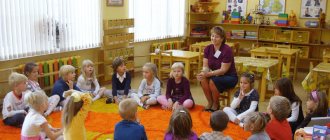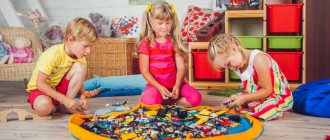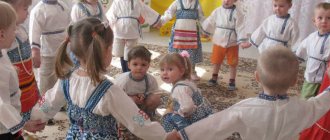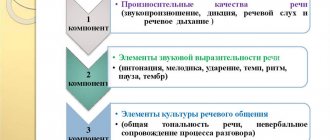Card index of conversations on moral education card index (senior group) on the topic
Card file of conversations on moral education
Topic #1: Why do they say “hello”?
Goal: To form in children the basic rules of etiquette when meeting. Introduce greeting methods. To consolidate ideas about the importance and necessity of using “kind words” in colloquial speech, to arouse the desire to use them.
Topic No. 2: “My good deeds”
Goal: to deepen children’s understanding of kindness as a valuable, integral quality of a person. Improve communication skills (the ability to listen to a friend, sincerely express one’s opinion, show kindness to the opinions of other children), skills of cultural communication with peers. Achieve friendly intonation expressiveness of speech. To cultivate in children friendly relationships, feelings of self-esteem and respect for others, the ability and desire to come to the aid of adults and peers.
Topic #3: “What is kindness?”
Goal: To form children’s idea of kindness as an important human quality. Encourage the desire to do good deeds; strengthen children’s ideas about good deeds, understand that polite words help people communicate. Form moral ideas about kindness. Cultivate kind feelings towards people around you.
Topic No. 4: “Hurry to do good”
Goal: Continue familiarization with the polar concepts of “good” and “evil.” Form a conscious attitude towards social norms of behavior, consolidate the skills of friendly behavior in everyday life. Introduce ways to resolve conflict associated with feelings of anger, as well as ways to manage and regulate mood. Continue to cultivate friendly relationships between children.
Topic No. 5: “If you are kind...”
Goal: To develop in children the need for friendly communication with others, to consciously show empathy and perform kind deeds. To teach to understand the meaning of proverbs about goodness, the ability to associate the meaning of a proverb with a specific situation. Teach children to show kindness and responsiveness to everyone who needs it.
Topic No. 6: “Polite words”
Goal: To teach children the rules of etiquette, forms and techniques of communication when meeting with acquaintances and strangers, the rules of using greetings. Help overcome shyness and stiffness in children. Develop the ability to express your opinion in a cultural way, listen carefully to your interlocutors. Teach formulas for expressing polite requests and gratitude.
Topic No. 7: “Accidentally and on purpose”
Goal: to develop moral feelings - regret, sympathy; develop gaming communication skills without hurting your partner’s interests.
Topic No. 8: “Learning to forgive our friends”
Goal: to develop children’s ability not to be offended by each other; develop the ability to distinguish between an accidental mistake and an intentional one and react accordingly; lead children to understand the words “peace-loving”, “touchy”.
Topic No. 9: “Why do there be fights?”
Goal: to develop communication skills in children; develop an understanding of the meaning of norms and rules of behavior among peers; cultivate the habit of behaving with dignity in every situation.
Topic No. 10: “Dreamers and liars”
Goal: to develop the ability to distinguish between deception and fiction, fantasy; develop a desire for truthfulness and tact.
Topic No. 11: “Let’s make peace”
Goal: develop the ability to restrain negative impulses, avoid conflicts, find words to evaluate behavior. Teach children to be responsive and sensitive.
Topic No. 12: “A good friend is a friend in need”
Goal: to form the idea that a true friend knows how to empathize and help in difficult times; develop the ability to be merciful to each other.
Topic No. 13: “How to behave during a conversation”
Goal: to introduce children to the rules of behavior during a conversation.
(Speak in a polite tone. Use “magic” words. Look at the interlocutor’s face. Do not keep your hands in your pockets. You should not eat during a conversation. If two adults are talking, the child should not interfere in their conversation, much less demand that it stop) .
Topic No. 14: “Good - Evil”
Goal: To teach to give a moral assessment to the actions of heroes, to cultivate a desire to be kind and humane. To help you understand that a kind person can be called a person who always helps others and does not remain indifferent in situations that are difficult for other people.
Teach to distinguish good deeds, create a desire to do good deeds towards people around you.
Topic No. 15: “Truthfulness”
Goal: To form ideas about the moral concept of “truthfulness”, to teach how to give a moral assessment of the hero’s actions, to help understand that a lie does not decorate a person.
Topic No. 16: “What a friend should be”
Goal: To form ideas about positive character traits and moral actions, to deepen ideas about friendship. Cultivate respect, patience and friendliness towards your comrades, teach them to correct their mistakes, and ask for forgiveness in conflict situations. Teach children to be responsive and sensitive.
Topic No. 17: “Be neat and tidy”
Goal: To teach children to take care of their appearance. Help you understand that a well-mannered person always looks neat.
Topic No. 18: “Truth is not true”
Goal: To explain to children that they should not deceive others, that they should always tell the truth, that truthfulness and honesty always please adults, that these qualities are highly valued in a person, that they are praised for telling the truth. Help children understand that any lie is always revealed, and the person who lies feels guilty not only for his own offense, but also for the fact that he told a lie.
Topic No. 19: “Goodwill”
Goal: to continue to instill in children a negative attitude towards rudeness. Explain to children that the one who teases not only offends others, but also causes harm to himself (no one wants to be friends with such a person).
Topic No. 20: “Games without quarrels”
Goal: Explain to children that a quarrel interferes with play and friendship. Learn how to resolve controversial issues, avoid quarrels, don’t get angry when you lose, don’t tease the loser...
Topic No. 21: “Politeness”
Goal: To teach children to use polite words, develop appropriate skills of cultural behavior, observe the rules of etiquette, using the example of images of literary heroes, stimulate positive forms of behavior and inhibit negative ones. That you need to communicate with others calmly, without shouting, that you should express your requests in a polite tone.
Topic No. 22: “Thrift”
Goal: To teach children to treat things with care and precision, otherwise they will quickly lose their appearance and become unusable. Teach to appreciate the work of those who made this thing, who bought it, earning money.
Topic No. 23: “Mutual assistance”
Goal: Explain to children that all people sometimes need support, but not everyone can ask for help; It is very important to notice the person who needs help and help him. That you need to help not only acquaintances, but also strangers.
Topic No. 24: “The desire to help”
Goal: To develop emotional responsiveness, the desire to help, showing empathy. Teach children to be responsive and sensitive.
Topic No. 25: “Generosity and Greed”
Goal: To reveal the meaning of the concepts of “greed” and “generosity”. Develop the ability to evaluate your attitude towards positive and negative actions. Understand that being greedy is bad, but generous is good.
Topic No. 26: “Why you need to be able to give in”
Goal: to teach children to avoid quarrels, give in and negotiate with each other. Develop the ability to evaluate your attitude towards positive and negative actions.
Topic No. 27: “Steps of kindness”
Goal: based on the content of Russian folk tales, to form in children an idea of justice, courage, modesty and kindness, to cultivate a negative attitude towards negative qualities: lies, cunning, cowardice, cruelty. Learn to convey your attitude to the content of the fairy tale and the actions of the characters.
Topic No. 28: “It’s better to be kind”
Purpose: To give children an idea of an indifferent, indifferent person and his actions. Teach children to distinguish between the external manifestations of an emotional state (anger, indifference, joy). Learn to analyze actions, find the cause of the conflict, ways to resolve conflict situations and promote their assimilation in behavior. Generalize the idea of kindness and evoke the desire to do good deeds.
Topic No. 29: “How to dress in cool weather?”
Goal: To generalize and consolidate the skills of correct, consistent dressing and changing clothes. Develop attention and observation. Foster independence, the ability to determine what to wear according to the weather.
Topic No. 30: “We are traveling in transport”
Goal: To familiarize children with the rules of behavior in transport: give way, be polite, do not push, etc. Develop attentiveness and observation. Cultivate a friendly attitude towards people traveling in transport.
Calendar-thematic plan for spiritual and moral education 1st grade
Introduction
I.Target section
I. _ 1. Explanatory note
The extracurricular activity program “Kindness will open the heart” implements a spiritual and moral direction in accordance with the requirements of the Federal State Educational Standard for students with mental retardation (intellectual disabilities).
This program is based on moral education, beneficially influencing all aspects and forms of a person’s relationship with the world: his ethical and aesthetic development, worldview and formation of civic position, patriotic and family orientation, intellectual potential, emotional state and general physical and mental development. The peculiarity of the program is that it helps maintain a healthy lifestyle for children. Personal education is possible only through the joint efforts of the family, educational institution and the state.
There is an emphasis on developing vitally important socially and psychological abilities, skills, motives and norms of behavior, nurturing emotions and feelings, promoting the successful adaptation of students to school, as well as living conditions in society, establishing an atmosphere of friendliness, which is so necessary for the formation of a team. When using the compiled program in work, a contribution is made to the strengthening and restoration of the psychological and mental health of pupils: work is carried out on the development of psychological processes, the emotional-volitional sphere, the formation of communication and cultural-hygienic skills, etc.
Extracurricular educational work has some advantages compared to academic work, since it has great opportunities for organizing various types of activities, allowing
use traditional and innovative forms and methods of work in an optimal combination. This program is intended for elementary school students and is designed for the first year of study.
Purpose of the program:
the creation of a unified educational space aimed at realizing the educational rights of students with mental retardation, the formation of a person - a citizen, a patriot, leading a healthy lifestyle, correction of developmental deviations for subsequent integration into society.
Tasks:
— creation of a favorable psychological atmosphere based on the principles of humanization of the educational process;
— formation of basic behavioral skills, education of students on the basis of a personality-oriented approach, instilling skills of collectivism, a tolerant attitude towards people around them;
— improving the work of the team in developing the spiritual and moral qualities of students’ personalities;
— broadening the horizons of students and forming a worldview about the surrounding reality;
Forms of work:
conversation, quizzes, drawing, games, role-playing games, dramatization, viewing presentations, analyzing and viewing pictures, listening to classical music, taking into account the age characteristics of schoolchildren.
1 hour per week is allocated for the implementation of the program, 33 school weeks.
II . Content section
II.1 . Personal results of mastering the program
By the end of studying the program on spiritual and moral education, the following personal qualities are formed in younger schoolchildren:
— formation and development of personal culture;
- formation of motivation for personal moral competence - “becoming better”, activity in educational and gaming activities;
- the formation of moral ideas about what is “good” and what is “bad”, as well as an internal attitude in the student’s mind to act “good”;
- development of goodwill and emotional responsiveness, understanding of other people and empathy for them;
— formation of family culture;
- formation of a respectful attitude towards parents, a conscious, caring attitude towards elders and younger ones;
— formation of responsibility for another person;
— willingness to follow ethical standards of behavior in everyday life and professional activities;
— development of ideas about the surrounding world in the totality of its natural and social components;
— expanding your social circle, developing cooperation skills with adults and peers in different social situations; accepting and mastering various social roles, the ability to work in a team, knowing what a sense of community is;
— formation of the need for communication and creative activity;
— introducing students to the development of the spiritual culture of society, passing on family and folk traditions;
— development of the student’s emotional sphere as the basis for the formation of a culture of feelings;
— formation of artistic and aesthetic taste and culture of behavior.
II.2 . Planned results of mastering the extracurricular program:
By the end of the school year, students acquire such skills and abilities, in accordance with age characteristics, as:
— development of creative abilities and interests, acquisition of experience in creative activities;
— education of a spiritually developed personality, ready for self-knowledge and self-improvement;
— formation of a humanistic worldview, national identity, love and respect for the values of national culture;
— education of artistic and aesthetic taste, development of feelings, emotions, figurative, associative, critical thinking;
— mastering the experience of using acquired knowledge and skills to broaden one’s horizons and consciously form one’s own cultural environment.
— formation of a culture of communication, behavior, aesthetic participation in events.
II.3 . Program content
1. “Who am I?” (2 hours)
Introductory part. Getting to know each student. Game: “I love.” View photos of each child and then get acquainted with family members.
2. Me and my family. Our family traditions . (2 hours)
Conversation about family, family members, living conditions and family values. Watch a short video about the importance of family and discuss it further. Instilling respectful attitude towards family members.
3. My friends and classmates. Games we play . (2 hours)
Conversation about friendship. Listening and learning the song “Strong Friendship”. Game "Together we"
4. “ Nature around me, what is it like? " (1 hour)
Fostering a value-based attitude towards nature. Watch the video and discuss it further.
5. “ Beauty is next to you .” (1 hour)
Repetition of covered material. Drawing up a general drawing “Palms on a tree”.
6. “ Hello, book! " (1 hour)
Getting to know the book. Cover, contents, pages. Careful attitude towards books. Viewing books of different genres (mini-exhibition of books).
7. “ A fairy tale, what is it like?” " (1 hour)
Introduction to the genre of a fairy tale, its structure (beginning, ending), quiz “Guess the Fairy Tale”.
8. Russian folk tales “Kolobok”, “Turnip”. (2 hours)
Listening to fairy tales with illustrations, watching videos with the plot of fairy tales, and further discussing them.
9. Guests from fairy tales. (1 hour)
View various stories from fairy tales and guess fairy-tale characters. Repetition of letters with the fairy-tale hero "Pinocchio".
10. Russian folk tale “Tops and Roots.” (1 hour)
Reading a fairy tale by a teacher with visual illustrations on an interactive board.
11. Quiz “Fairy-tale characters”. (1 hour)
Solving riddles with the participation of fairy-tale characters, with the presentation of prizes (bookmark for the book).
12. Leafing through the pages of books. Final lesson. (1 hour)
Drawing on the theme of read fairy tales.
13. Take care of books . (1 hour)
A conversation about being careful while reading and looking at books and textbooks (no dirtying, no drawing, no reading while eating). Checking books and textbooks and putting them in order.
14. Help a friend. (2 hours)
Conversation about friendship. Each child's story about his friend. Game "Friendly guys"
15. About the importance of respecting elders. (1 hour)
Watch a social video with further discussion. Question to the guys: “What help can you provide to adults?”
16. How to protect nature? . (1 hour)
View a multimedia presentation with images of a polluted environment, with further ways to solve problems.
17. “ Helping animals .” (2 hours)
Demonstration of a presentation with images of wild and domestic animals. Solving riddles on the theme “Animals”. Rules for caring for pets.
18. What is caring? . (1 hour)
Final lesson on the topics covered. Answers to questions about help, work with illustrations.
19 . " Good deeds" . (1 hour)
Conversation about good deeds. Listening to a story about kindness and further discussing it.
20. Emotions and feelings . (1 hour)
Introduction to the topic. Unraveling people's emotions in pictures. Exercise “Touch, to...”. Exercise “Guess it.” Game with the ball "Don't drop it." Exercise "Round dance". Reflection.
21. Politeness and diligence . (1 hour)
Introducing new concepts. Reading and analysis of the parable about politeness. Conversation on the topic.
22. I'm visiting . (1 hour)
Conversation about rules of conduct when visiting. View pictures with the plot (away).
23. Visiting the museum, rules of conduct . (1 hour)
Conversation about rules of conduct in museums. What museums are there in our city?
24. A smile will make everyone warmer . (1 hour)
A conversation about the need for a cheerful spirit and good mood. Listening to the song “From a Smile.”
25. Compiling a wall newspaper . (1 hour)
Collective work, compiling a wall newspaper on the topics covered.
26. The road to good deeds . (1 hour)
Summing up the results for the year. Repetition of all topics.
III . Organizational section
III.1 . Calendar and thematic planning
1st quarter – hour
| № | Lesson topic | Personal results | |||||||||
| Love for your surroundings | |||||||||||
| 1 | "Who am i?" | Meeting classmates. Self-awareness of oneself as a person. | |||||||||
| 2 | I and my family. Our family traditions. | Acceptance and mastery of various social roles, the ability to interact with people, work in a team. Valuable attitude and love for loved ones. | |||||||||
| 3 | My friends and classmates. The games we play. | Expanding your social circle, developing cooperation skills with adults and peers in different social situations; acceptance and development of various social roles. | |||||||||
| 4 | “The nature around me, what is it like?” | Gaining initial experience of emotional and sensory direct interaction with nature. | |||||||||
| 5 | Beauty is near you. | Learning to see beauty in the surrounding world, the nature of the native land, in what surrounds students in the space of school and home. | |||||||||
| 2nd quarter - hour Books are best friends. | |||||||||||
| 6 | “Hello, book!” | Introducing to book culture as part of spiritual culture. | |||||||||
| 7 | Fairy tale, what is it? | Respectful and careful attitude towards the book, instilling an interest in reading, and aimed at developing cognitive interest and speech creativity. | |||||||||
| 8 | Russian folk tales “Turnip”, “Kolobok”. | Listening comprehension of texts from various genres of children's literature, development of coherent speech. | |||||||||
| 9 | Guests from fairy tales. | Forming interest in the book as a work of art, a source of educational information. | |||||||||
| 10 | Russian folk tale “Tops and Roots.” | To increase children's cognitive interest in books as a source of educational information. | |||||||||
| 11 | Quiz "Fairy-tale characters" | The ability to correctly correlate a drawing with reality, to see exactly what is depicted on it, thereby improving the interpretation of the drawing, i.e., understanding its content. | |||||||||
| 12 | Leafing through the pages of books. Final lesson | Formation of sensory perception of the world, artistic taste. The development in a child of aesthetic sensitivity, expressed, first of all, in the desire for beauty in all its manifestations. | |||||||||
| 3rd quarter - hour Help is the key to success! | |||||||||||
| 13 | Let's take care of books! | Interest in reading, desire for a neat attitude towards things. | |||||||||
| 14 | Help a friend! | Establishing friendly relationships in a team based on mutual assistance and mutual support. | |||||||||
| 15 | On the importance of respecting elders | Respectful, friendly and respectful attitude towards elders. | |||||||||
| 16 | How to protect nature? | A valuable attitude towards nature and all forms of life. Caring for plants and animals. | |||||||||
| 17 | Help animals | Developing interest in nature, natural phenomena and forms of life, understanding the active role of man in nature. | |||||||||
| 18 | What is caring? | Distinguishing between good and bad deeds. | |||||||||
| 4th quarter - hour I'm learning to be polite | |||||||||||
| 19 | "Good deeds" | The ability to organize one’s activities, determine its goals and objectives, choose means of achieving the goal and apply them in practice, evaluate the results achieved. | |||||||||
| 20 | Emotions and feelings | The ability to navigate the world around you, choose goals and meaning in your actions and actions, and make basic decisions. | |||||||||
| 21 | Politeness and diligence | Possession of communication skills and accepted rituals of social interaction. | |||||||||
| 22 | I am at a friend's place | Willingness to follow ethical standards of behavior in everyday life. | |||||||||
| 23 | Visiting the museum, rules of conduct. | Expanding your social circle, developing cooperation skills with adults and peers in different social situations; acceptance and development of various social roles. Willingness to follow ethical standards of behavior in everyday life and professional activities. Understanding beauty in art and in the surrounding reality. | |||||||||
| 24 | A smile will make everyone brighter. | Possession of communication skills and accepted rituals of social interaction. | |||||||||
| 25 | Compiling a wall newspaper | The ability to organize one’s activities, determine its goals and objectives, choose means of achieving the goal and apply them in practice, evaluate the results achieved. | |||||||||
| 26 | The road to good deeds | Final lesson. | |||||||||
III . 2. List of references
- We educate the individual. Educational work at school/N.F. Dick. – Rostov n/d: Phoenix, 2015. – (I give my heart to the children.)
- Ganina M.E. Children's book world. // Magazine “Kindergarten from A to Z”, 2005, No. 1.
- Gurovich L. M., Beregovaya L. B., Loginova V. I. The child and the book. – Moscow: Enlightenment, 1992
- Demidova O.N. Be polite at all times. Lesson notes on ethical grammar with children. Practical guide for educators. – Voronezh: Lakotsenin S.S., 2012.



